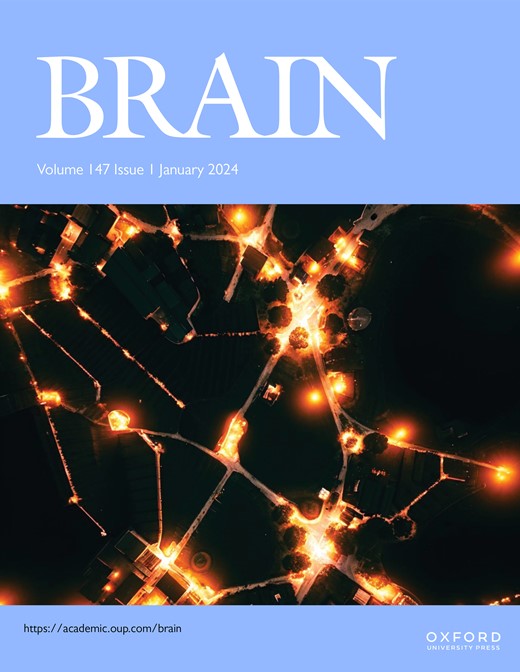FGF14-SCA27B GAA-TTC 重复的体细胞不稳定性揭示了小脑中明显的扩增偏向
IF 10.6
1区 医学
Q1 CLINICAL NEUROLOGY
引用次数: 0
摘要
脊髓小脑共济失调 27B(SCA27B)是一种常见的常染色体显性共济失调,由 FGF14 内含 GAA-TTC 重复扩增引起。神经病理学研究表明,神经元缺失主要局限于小脑。虽然该重复位点在代际传递过程中极不稳定,但它是否会在整个生命过程中表现出大脑镶嵌和渐进不稳定性仍是未知数。我们对来自69名患者的156份连续血液样本、成纤维细胞、诱导多能干细胞以及来自6名对照组和6名SCA27B患者的尸检脑组织中的FGF14 GAA-TTC重复位点体细胞不稳定性进行了分析,同时使用靶向长读程测序技术进行了甲基化分析。外周组织显示出极小的体细胞不稳定性,在超过20年的时间里没有显著变化。在尸检后的大脑中,除小脑半球和蚓部外,GAA-TTC 重复序列在所有区域都非常稳定。小脑半球和蚓部的体细胞扩增水平平均分别是其他受检脑区的 3.15 倍和 2.72 倍。此外,大脑中的体细胞扩增水平随重复长度和 FGF14 的组织表达而增加。我们发现,患者和对照组死后小脑半球中野生型和扩增型 FGF14 等位基因的甲基化没有明显差异。总之,我们的研究揭示了FGF14 GAA-TTC重复序列具有小脑特异性扩增偏倚,这可能是SCA27B纯小脑受累的原因。本文章由计算机程序翻译,如有差异,请以英文原文为准。
Somatic instability of the FGF14-SCA27B GAA•TTC repeat reveals a marked expansion bias in the cerebellum
Spinocerebellar ataxia 27B (SCA27B) is a common autosomal dominant ataxia caused by an intronic GAA•TTC repeat expansion in FGF14. Neuropathological studies have shown that neuronal loss is largely restricted to the cerebellum. Although the repeat locus is highly unstable during intergenerational transmission, it remains unknown whether it exhibits cerebral mosaicism and progressive instability throughout life. We conducted an analysis of the FGF14 GAA•TTC repeat somatic instability across 156 serial blood samples from 69 individuals, fibroblasts, induced pluripotent stem cells, and post-mortem brain tissues from six controls and six patients with SCA27B, alongside methylation profiling using targeted long-read sequencing. Peripheral tissues exhibited minimal somatic instability, which did not significantly change over periods of more than 20 years. In post-mortem brains, the GAA•TTC repeat was remarkably stable across all regions, except in the cerebellar hemispheres and vermis. The levels of somatic expansion in the cerebellar hemispheres and vermis were, on average, 3.15 and 2.72 times greater relative to other examined brain regions, respectively. Additionally, levels of somatic expansion in the brain increased with repeat length and tissue expression of FGF14. We found no significant difference in methylation of wild-type and expanded FGF14 alleles in post-mortem cerebellar hemispheres between patients and controls. In conclusion, our study revealed that the FGF14 GAA•TTC repeat exhibits a cerebellar-specific expansion bias, which may explain the pure cerebellar involvement in SCA27B.
求助全文
通过发布文献求助,成功后即可免费获取论文全文。
去求助
来源期刊

Brain
医学-临床神经学
CiteScore
20.30
自引率
4.10%
发文量
458
审稿时长
3-6 weeks
期刊介绍:
Brain, a journal focused on clinical neurology and translational neuroscience, has been publishing landmark papers since 1878. The journal aims to expand its scope by including studies that shed light on disease mechanisms and conducting innovative clinical trials for brain disorders. With a wide range of topics covered, the Editorial Board represents the international readership and diverse coverage of the journal. Accepted articles are promptly posted online, typically within a few weeks of acceptance. As of 2022, Brain holds an impressive impact factor of 14.5, according to the Journal Citation Reports.
 求助内容:
求助内容: 应助结果提醒方式:
应助结果提醒方式:


